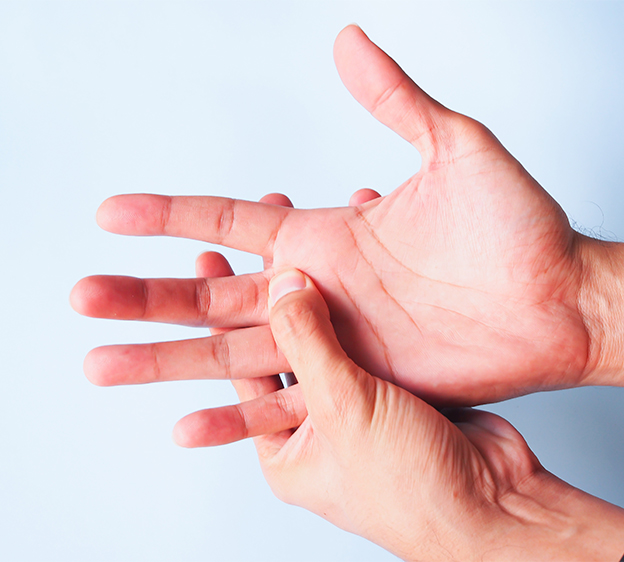
Known medically as stenosing tenosynovitis, trigger finger is a prevalent ailment impacting the tendons in your fingers or thumb, resulting in impaired movement. Despite the discomfort and inconvenience trigger finger brings, various treatment approaches, such as incorporating trigger finger exercises and stretches at home, can effectively address symptoms and improve flexibility.
What is Trigger Finger? Symptoms and Risk Factors
Trigger finger occurs when the protective covering around the tendons becomes inflamed or irritated, disrupting the smooth movement of the tendons as you flex and extend your finger. This narrowing of the covering space can lead to difficulties in finger movement, often resulting in a clicking sensation or the finger becoming temporarily stuck in a bent position. Additionally, tendon swelling or irritation may exacerbate trigger finger symptoms.
Common symptoms of trigger finger may manifest as pain, swelling, stiffness or limitations in movement, such as popping sensations or restricted finger mobility.
Conditions Associated With Trigger Finger
While trigger finger is more prevalent in individuals over 40 and tends to affect women more than men, various underlying conditions have been linked to its development.
"Long-term conditions such as diabetes and rheumatoid arthritis are associated with trigger finger," explains Dr. Vandit Sardana, MSC, FRCSC, orthopedic surgeon with Beaufort Memorial Orthopaedic Specialists. “Furthermore, specific factors such as repetitive motions or overuse injuries can also contribute to the onset of trigger finger."
Other conditions that are associated with trigger finger include:
- Carpal tunnel syndrome: Individuals who have undergone surgery for carpal tunnel syndrome may have an increased risk of developing trigger finger.
- Diabetes: Those with diabetes are at a higher risk of experiencing trigger finger, although the precise relationship between the two conditions is not yet fully understood.
- Inflammatory conditions: Inflammatory disorders like rheumatoid arthritis can cause inflammation in the tendons and their protective sheaths, leading to trigger finger symptoms.
- Previous hand injuries: Past hand injuries or certain medical conditions can elevate the likelihood of developing trigger finger.
Read More: Hand & Wrist Pain: Causes and Treatment
Trigger Finger Exercises and Stretches
Incorporating gentle stretching exercises into your daily routine can improve flexibility and alleviate symptoms of trigger finger. Here are some simple stretches you can try at home:
Finger Lifts
Place your hand flat on a table with your palm facing down. Slowly lift each finger one at a time off the table, holding for a few seconds before lowering it back down. Repeat 10 times for each finger.
Tendon Gliding
Start by holding your hand in front of you with your fingers straight. Slowly curl your fingers into a fist, starting with the fingertips and then curling to the knuckles. Hold a fist position for a few seconds before straightening the fingers again. Repeat 10 times.
Thumb Stretch
Hold your hand out with your fingers straight. Gently pull your trigger thumb toward the base of your pinky finger with the opposite hand. Hold for 15-30 seconds and repeat on each hand.
Stretching the Palm
Spread your fingers as wide as you can while keeping your palm flat on a surface. Hold for 10-15 seconds, then release. Repeat 5-10 times.
Clenched Wrist Bend Stretch
With your thumb facing up, make a loose fist and place it on a flat surface. Bend your wrist to move your fingers toward your body and hold for two seconds. Relax and move your hand back to the starting position. Repeat 10 times.
Bent Finger Stretch
Bend your thumb toward your palm, with the goal of touching the tip of your thumb to the tip of your index finger. Hold for 10 seconds. Do the same stretch with all your other fingers. Complete this stretch four to five times each day.
Resistance Exercise with a Rubber Band
With thumb and fingertips together like you’re pinching something and be sure all your fingertips are touching. Put a rubber band around your fingers and your thumb. Be sure the rubber band is comfortable and not painfully resistant. Next, open your hand and push against the rubber band. Over time, you’ll be able to use more rubber bands. Repeat 10 times and complete exercise five times a day.
“Stretches can make a big difference in your trigger finger symptoms, Dr. Sardana says, “so try them consistently before you consider more invasive treatments.”
Treatments and Home Remedies for Trigger Finger
Trigger finger treatments vary based on the severity of symptoms. Mild cases can often be treated with at-home remedies, including:
- Finger splinting: Wearing a splint can keep the finger in a straight position and help rest the tendon.
- Ice: Applying ice to affected areas may help reduce swelling and inflammation.
- Over-the-counter medications: Taking nonsteroidal anti-inflammatory drugs can help reduce pain and inflammation.
- Rest: Avoid activities that cause repetitive gripping or hand strain, which can worsen inflammation.
More severe cases may require medical intervention, including steroid injections or a minor surgical procedure known as “trigger finger release.”
“In mild cases, resting your finger and avoiding aggravating activities allows your condition to improve,” Dr. Sardana says. “However, without treatment, some cases may persist or worsen.”
Read More: Exercise for Arthritis: Move More, Hurt Less
Long-Term Outlook for Trigger Finger Relief
Trigger finger can be a painful and frustrating condition, but with the right treatment and self-care, most people can manage their symptoms. Whether you're using at-home stretches or seeking medical treatments such as steroid injections, it’s key to address the condition early before it worsens. With the proper care, you can reduce pain, improve flexibility and get back to your normal activities.
Trigger finger can be painful, but the experts at Beaufort Memorial can help. Request an appointment with an orthopedic specialist to start the road to recovery.

